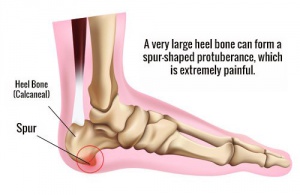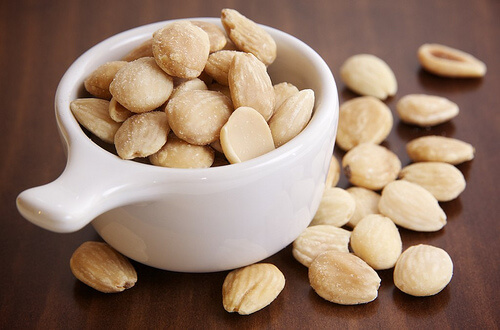How to Prevent Heel Spurs

Heel spurs are caused by a calcification of the conjuncture between the tendons and the calcaneus bone of the foot. It makes normal heel support difficult, creating aches and pains associated with inflammation.
There are two types of heel spurs: posterior inferior spurs (underneath the heel), which are the most common, and posterior superior spurs (where the Achilles tendon attaches).
What causes heel spurs?
This condition is caused by excessive stretching of the plantar fascia (a band of thick tissues that cover the bones at the base of the foot), causing inflammation known as plantar fasciitis.
The body accumulates calcium in injured areas with the intent of healing tissues. As a result, this bony prominence grows progressively.
This situation can be caused by obesity, poor posture, excessive athletic strain, use of improper footwear, overloading the tendon, and standing for long periods of time.
Congenital spurs can appear as well. They irritate tendons and cause inflammation.
Plantar fascia inflammation has been related to the development of the spur, but you can also have fasciitis without the spurs. Plantar fasciitis causes an intense pain in the sole of the foot that radiates toward the heel.
How are spurs diagnosed?
Spurs can show up on X-rays, which will show a protuberance pointing towards the toes, measuring between one and five millimeters. Some people can have this condition and show no symptoms.
What are the symptoms?
First, let’s talk about the inflammatory pain caused by overloading the tendons. People can feel pain in the morning after taking their first steps. They can feel like they’re stepping on a nail. The pain generally subsides with rest, but returns once again when the foot is used for support. Also, carrying heavy objects can worsen the symptoms.
This article may interest you: 9 Pressure Points that Will Help You Relieve Pain
Treatments
- Using orthotic insoles (inserts for spurs) improves foot support and alleviates tension in the tendons.
- Physical therapy: use of heat or cold to relieve pain.
- Stretching exercises.
- Local ultrasound treatments.
- Shock waves: High energy ultrasound waves can dissolve calcification.
- Applying pain relievers to the area.
- Surgery is performed in worst-case scenarios when no other treatment has produced results.
Natural remedies to relieve spur symptoms
- Verbena: cook a handful of these leaves in water for 15 minutes. Moisten a few compresses and then apply them to the affected area.
- Wormwood: apply moist compresses to the affected areas.
- Parietaria: moisten a compress with an infusion of a handful of dried leaves and one liter of water.
- Echinacea: possesses anti-inflammatory properties. Prepare an infusion with one tablespoon of the dried plant in one cup of water. Drink a few cups a day.
How to prevent heel spurs
Obviously, the best way to prevent heel spurs is to avoid their causes, such as obesity, excessive efforts, bad positions, improper footwear, among others.
You can also prevent heel spurs with your diet by consuming foods that contain magnesium, silicon, and zinc since they help keep our muscles and tendons healthy:

- Magnesium: mollusks, lettuce, spinach, asparagus, grains, legumes, and dry fruit have this mineral.
- Silicon: whole oat flour, parsley, nettle (consult a naturopath regarding ways to consume this), beets, green beans.
- Zinc: peanuts, pumpkin and pumpkin seeds, sesame butter and flour, wheat sprouts, oysters.
- Omega-3 helps reduce inflammation. You can find it in oily fish, fish oil, linseed, canola, and walnut oil. You can also find it in cucumbers, strawberries, spinach, soy, walnuts, almonds, and lettuce.
Beneficial fruits
Pineapple and papaya are two fruits that can help due to their high bromelain contents. Bromelain has anti-inflammatory properties. You should eat them together to boost their effects.
In conclusion, a healthy and balanced diet will help us prevent heel spurs and other conditions and diseases.
All cited sources were thoroughly reviewed by our team to ensure their quality, reliability, currency, and validity. The bibliography of this article was considered reliable and of academic or scientific accuracy.
- Imagen principal cortesía de © wikiHow.com
- Toumi, H., Davies, R., Mazor, M., Coursier, R., Best, T. M., Jennane, R., & Lespessailles, E. (2014). Changes in prevalence of calcaneal spurs in men & women: a random population from a trauma clinic. BMC musculoskeletal disorders, 15, 87. doi:10.1186/1471-2474-15-87
https://www.ncbi.nlm.nih.gov/pmc/articles/PMC3995580/ - Plantar fasciitis and the calcaneal spur: Fact or fiction? (2002). Johal KS, Milner SA.
https://www.ncbi.nlm.nih.gov/pubmed/22326003
This text is provided for informational purposes only and does not replace consultation with a professional. If in doubt, consult your specialist.








